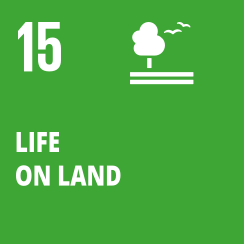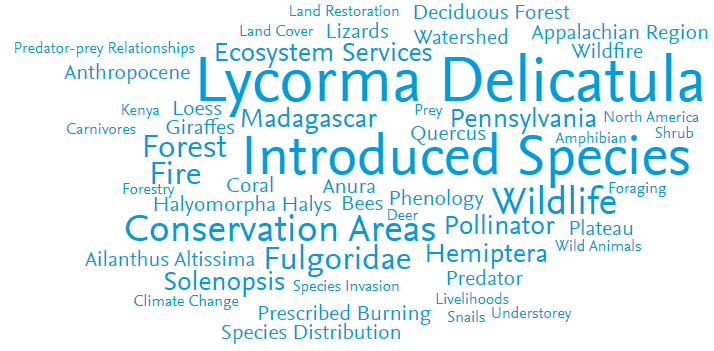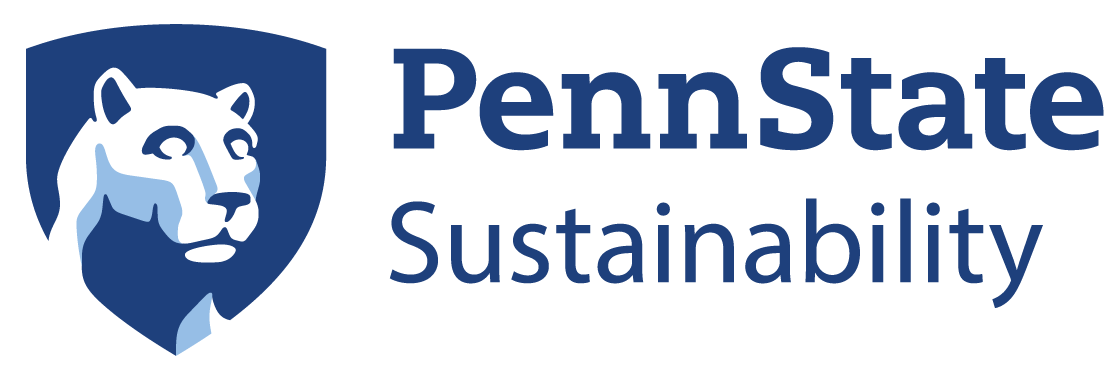
Protect, restore and promote sustainable use of terrestrial ecosystems
The targets that this goal aims to hit include: conservation, restoration and sustainable use of terrestrial and inland freshwater ecosystems; sustainable management of all types of forests; combating desertification and restoring degraded land and soil; the conservation of mountain ecosystems; an end to poaching and trafficking of protected species of flora and fauna; preventing the introduction and significantly reducing the impact of invasive alien species on land and water ecosystems; integrating ecosystem and biodiversity values into national and local planning; and, the financing of sustainable forest management. See below for Penn State’s work on the targets and indicators for this goal.

Source: SciVal.com | This word cloud was created using publications from Penn State researchers
Related News
Penn State pollinator experts author a new book that explores the lives of bees
Two renowned pollinator scientists in Penn State’s College of Agricultural Sciences and the Huck Institutes of the Life Sciences have co-authored a book that sheds light on one of the Earth’s most invaluable resources: bees. Christina Grozinger, the Publius [...]
A rediscovered soil archive – more than a century old – could show how years of farming alters soil
Soil science is a relatively new field and becoming more critical in the work to keep soil healthy and productive. The discovery of century-old soil samples at a land-grant university could offer big clues into [...]
Discovery of a hybrid lineage offers clues to how trees adapt to climate change
The discovery of a hybrid population of poplar trees in western Wyoming has provided insight into how natural hybridization informs the evolution of many plant species, according to a team led by Penn State researchers. [...]
Type of plastic film on high tunnels can filter sunlight, influence plant growth
High-tunnel growing systems, sometimes called hoop houses, have gained popularity for their ability to enhance growth conditions and extend the growing season of horticultural crops. Now, a team led by Penn State researchers has demonstrated that [...]
$1M USDA grant to perfect weed killing method in organic crop production
Weeds are a major factor limiting yield in organic vegetable and other horticultural crop systems, and the lack of effective biological weed-management solutions is a significant obstacle to the adoption of organic farming practices. To [...]
Adding fall blooming plants may help both managed and wild bees in cities
There are nearly 4,000 native bee species in the United States, contributing to pollination in agricultural, urban and natural landscapes. Honey bees, however, are not native to the U.S., which has led to concerns that [...]
Supporting Evidence
Yes, Penn State supports and organizes events which promote conservation and sustainable utilization of land, forests, and wild land.
The EarthTalks series, supported by Penn State’s Earth and Environmental Systems Institute, offers free public talks featuring distinguished researchers and practitioners from Penn State, as well as from other universities, government agencies, and nonprofit organizations, on a variety of conservation topics including wildfire management.
The Department of Ecosystem Science and Management conducts outreach work to connect the resources of the Department of Ecosystem Science and Management with community members, industry, and institutions in Pennsylvania and beyond by offering the latest research-based information and meaningful programming for adults and youth through Extension and 4-H programs.
Penn State Extension offers community workshops which promote conservation and sustainable utilization of the land including:
- Tree Tenders webinar
- A Community Forestry Institute workshop and Community Forestry webinar for members of municipal commissions, municipal staff, community advocates, and volunteers as well as Forest Management workshops.
- Master Watershed Steward Program which provides residents with extensive coursework in water and natural resources. In exchange for 40 hours of instruction, candidates agree to contribute 50 hours of volunteer service their first year, followed by 20 hours per year thereafter.
Shaver’s Creek Environmental Center promotes Citizen Science opportunities such as Project FeederWatch and Monarch Watch.
The Forestland Management Office manages more than 8,000 acres of forest owned by Penn State which are used for teaching, research, recreation, and as a renewable resource for timber and other forest products.
Ag Progress Days features a wide variety of crop management, wildlife and conservation education, as well as tours that focus on wildlife habitat and stream buffers.
In 2023, the HUB-Robeson Galleries included events which promoted conservation and sustainable utilization of the land, including forests and wild land, in exhibits such as “Magnificare” which shed light on sustainable actions, celebrated mutually thriving communities and environments, and illuminated interdependence and engagement while magnifying awareness, reciprocal responsibility, and protection of each other and our planet.
The HUB-Robeson Galleries 2021 – 2022 exhibition schedule included events and several exhibits that explore our relationships with wild birds.
Penn State’s Earth and Environmental Systems Institute and Marcellus Center for Outreach and Research co-hosted the 2022 Shale Network Workshop “Ten Years of Unconventional Resource Development: Lessons Learned and Future Directions”
A visiting sculpture installation brought The Lost Bird Project sculptures to locations in Centre, Blair and Huntingdon counties, including at Shaver’s Creek, locations on the Penn State University Park and Altoona campuses, and the Millbrook Marsh Nature Center in State College. It recognizes the tragedy of modern extinction by immortalizing five North American birds in sculpture.
Learn more about Penn State’s progress on the UN’s Sustainable Development Goals HERE and on SDG15 HERE.
Penn State offers and encourages sustainably farmed food on campus in three main ways:
- The Student Farm produce, the bulk of which is picked and packed by students, prioritizes sales straight to campus dining. Managing chefs in the five dining commons place weekly orders with the farm from the farm pick list.
- The Food Services Sustainability webpage describes Penn State priorities as supporting local vendor purchasing and describes its partnership with the Student Farm as a main way to bring hyper-local produce to the dining commons. See the “Local Foods” section for descriptions of impacts related to local foods and sustainably farmed choices.
- The Green Events guide offers guidance on sustainable event planning which includes a focus on seasonal and local food options.
While there is no formal plan in place, purchasing has been asked to work with vendors that prioritize sustainability and social responsibility. Vendors should provide transparency regarding sourcing, labor, and environmental activities. For example, Do they have sustainability goals? Emission reduction goals? Do they have an ESG report available?
Learn more about Penn State’s progress on the UN’s Sustainable Development Goals HERE and on SDG15 HERE.
Yes, Penn State works directly to maintain and extend existing ecosystems and their plant and animal biodiversity, including ecosystems under threat.
The university owns and manages land where ecosystems and biodiversity are maintained and extended. These include:
- an Arboretum on the University Park campus;
- the Penn State Experimental Forest, 8,000 acres of forest that supports water resource and environmental investigations focused on sustainability of hardwood forests, water yield, and water quality;
- Shavers Creek Environmental Center which supports a field laboratory and active research projects related to the conservation of ecosystem biodiversity;
- Musser Gap, a 355 acre parcel which stewards, celebrates and protects regionally unique natural resources including the local water supply, plant and animal species; and
- 62-acre Millbrook Marsh, a World Database on Protected Areas IUCN management category III Natural Monument or Feature which is owned by the university, managed by Clearwater Conservancy, and operated by Centre County Parks and Recreation. All of these projects work directly to maintain and extend existing ecosystems and their plant and animal biodiversity.
The university also works to maintain and extend existing ecosystems and their biodiversity through research and teaching. For example:
- Penn State’s Center for Pollinator Research prioritizes developing and implementing integrative, multidisciplinary approaches to improving pollinator health, conservation, and management for ecosystems services through research, education, outreach and policy.
- The Ecosystem Science and Management department engages in research, teaching, and service about maintaining and expanding ecosystems and ecosystem biodiversity. Undergraduate programs such as the Forest Ecosystem Management program combines in-depth, hands-on science education for all students to participate in meaningful research in Forest Health, Restoring Ecosystem Function and Service, Scaling Up Ecosystem Management, and Watershed Resilience.
Learn more about Penn State’s progress on the UN’s Sustainable Development Goals HERE and on SDG15 HERE.
Yes, Penn State offers numerous educational programs on ecosystems that look at wild flora and fauna for local and national communities.
The Arboretum at Penn State offers guided tours (for community members and K-12 schools) that provide educational programs on local ecosystems/flora/fauna and events such as Bird Walks, Exploring Plants, and Arboretum Insects. The reach of educational programs is extended through videos and webinars provided online, such as a video about the Pollinator and Bird Garden, the Garden Wanderings video series.
Shaver’s Creek Environmental Center offers public programs and events for local and global stakeholders to look at wild flora and fauna in person and online. Summer Camps provide opportunities for youth to learn about flora and fauna.
On the Penn State DuBois campus, annual bird banding programs which invite campus and community to participate in hands-on learning about wildlife conservation practices.
The Penn State Office of Science Outreach Science-U summer camps provide summer camp opportunities for students in grades 2-12 to learn about water, habitats, and the local ecology.
Penn State’s Center for Pollinator Research provides a range of free educational resources for local and national communities. These include the Beescape story map, how to landscape for pollinators, and research on a range of topics with multiple global research partners.
Penn State Extension offers a variety of workshops and webinars for free and some for a fee if professional development or certification credits are associated. For example, wildlife topics include topics such as Forestry for Birds, Wildlife Food Plots, Native Plants of Pennsylvania, and Amphibians and Reptiles in Your Woods. Other topics that provide workshops and webinars on ecosystems for local and global communities include Forest Management and Urban Forestry.
Learn more about Penn State’s progress on the UN’s Sustainable Development Goals HERE and on SDG15 HERE.
Yes, the university offers educational programs and outreach for local or national communities on sustainable management of land for agriculture and tourism.
LOCAL
The Student Farm offers free and paid programs on sustainable agriculture and nutrition. Some events are planned and hosted by Student farm staff and students. Other events are collaboratively hosted to support gardeners of all kinds and promote the community gardens located throughout the State College area. Events have included a Community Seed Swap, growing seedlings on campus for Meals on Wheels participants to select and have delivered to their homes in five-gallon buckets.
The Outreach program at Penn State provides free materials on sustainable agriculture on topics from small-scale cricket production to conservation biocontrol.
LOCAL AND NATIONAL
The Extension Office offers free publicly available resources (programs, webinars, etc.) for sustainable land management and agriculture. Land management programs include webinars, workshops, online course, and videos. Webinars, videos, and most workshops are free. Online courses have an associated fee of $39-$135 USD.
Tourism resources include articles, news, and webinars and are all available for free.
Learn more about Penn State’s progress on the UN’s Sustainable Development Goals HERE and on SDG15 HERE.
Penn State has Guiding Principles on sustainable land management and conservation practices to ensure the conservation, restoration and sustainable use of terrestrial ecosystems associated with the university, in particular forests, mountains and drylands. These are described in the Campus Planning and Sustainable Campus sections of the guiding principles document. This links directly to the Penn State LEED policy that details information on environmental conservation and site assessments including restoring natural habitats.
Environmental resources are mapped in the Campus Master Plan.
Penn State’s University Park campus has been a certified Bee Campus through the Xerces Society since 2018.
The Penn State Erie, the Behrend College has been a recognized Tree Campus since 2014 by the Arbor Day Foundation.
Penn State’s Hershey Medical Center was awarded Tree Campus Healthcare designation by the Arbor Day Foundation in 2023, one of 35 inpatient health care facilities nationwide to earn recognition.
Penn State has partnered with the Clearwater Conservancy, a non-profit organization that aims to conserve and restore the natural resources in central Pennsylvania, to conserve a piece of property in Penn State’s boundary known as Musser Gap.
Learn more about Penn State’s progress on the UN’s Sustainable Development Goals HERE and on SDG15 HERE.
Yes, Penn State monitors and protects IUCN Red Listed species, in particular the American Chestnut. and has in place Policy AD38 which delegates responsibility for environmental regulatory compliance to the Office of Physical Plant (OPP). OPP must align with Pennsylvania State’s Threatened and Endangered Species regulations.
Penn State’s Arboretum is a partner institution for the American Chestnut Foundation.
Penn State Erie – the Behrend campus, operates the Lake Erie Regional Grape Research and Extension Center, which has 15 hybrid chestnut tree species bred by The American Chestnut Foundation. The goal was and is to create a chestnut tree that is as genetically close to the American species as possible, while also inheriting the resistance to chestnut blight from the Chinese species.
Penn State’s historic and ongoing work with conservation management of American Chestnuts is detailed in articles “Blight-resistant American chestnut trees nearing reality,” “American chestnut rescue will succeed, but slower than expected,” and most recently “Researchers identify new threat to American chestnut trees.”
The Penn State STARS report on biodiversity lists the endangered species supported by the Millbrook Marsh habitat, a World Database on Protected Areas IUCN management category III Natural Monument or Feature, which is owned by Penn State.
Learn more about Penn State’s progress on the UN’s Sustainable Development Goals HERE and on SDG15 HERE.
Yes, Penn State does include local biodiversity into any planning and development process. For example:
- During the construction of new buildings, the LEED V4 policy is the guiding document for planning and development related to protecting and restoring natural habitat, as well as conducting environmental assessments. It requires preservation and protection from all development and construction activity in any Greenfield areas on the site and that native and adapted species only will be used.
- The Sustainable Landscape Implementation Plan goals include:
- Optimize landscape management through ecological intensification of the campus landscape
- Increase landscape performance and ecological health in order to increase food and habitat access for wildlife and protect existing and expand & diversify habitat areas
- The Campus Master Plan designates Environmental Resource areas/Environmentally Sensitive Areas/Protected Areas to recognize the importance of maintaining the quality of both potable and surface waters and the need to protect local ecological communities. The planning and development of Penn State’s campuses strives to exemplify the University’s commitment to environmental stewardship and balances the needs of present and future generations. Approximately 860 acres of land are in this land use category.
- Several campuses across the Commonwealth also have Master Plans that prioritize conserving biodiversity. For example:
- The Altoona campus master plan includes a focus on stream Restoration: erosion control, maintenance, and environmental improvements.
- A main goal of the Behrend campus master plan is to “sustain and promote the unique environmental character of campus as an academic, recreational, and community resource” and to “Integrate environmental sustainability and stewardship principles in the planning, design, construction, and operation of campus buildings and grounds to improve the health and well-being of our community.”
Examples of how Penn State acts to include local biodiversity into planning and development include:
- The Penn State STARS biodiversity report describes efforts in promoting and conserving biodiversity on university property. These include Millbrook Marsh is a 62-acre protected area owned by Penn State and operated by the Centre Region Recreation Authority, which the World Database on Protected Areas includes in IUCN management category III, Natural Monument or Feature and is in IUCN management category V, Protected Landscape/ Seascape for the marsh and the fen areas.
- Millbrook Marsh is a 62-acre protected area owned by Penn State and operated by the Centre Region Recreation Authority, which the World Database on Protected Areas includes in IUCN management category III, Natural Monument or Feature and is in IUCN management category V, Protected Landscape/ Seascape for the marsh and the fen areas.
- Shaver’s Creek Environmental Center and adjacent Stone Valley Recreation Area which preserve natural forested habitat.
- Musser Gap to Valleylands is a 355-acre parcel designed to provide ecosystem restoration.
Learn more about Penn State’s progress on the UN’s Sustainable Development Goals HERE and on SDG15 HERE.
Yes, the university has requirements and guidelines to reduce the impact of alien species on Campus and in the state. The university requires training about and inspections for the Spotted Lanternfly (SLF), an alien and invasive species that has the potential to greatly impact agricultural crops in Pennsylvania including grapes, hops, and hardwoods and reduce the quality of life for people living in heavily infested areas.
Penn State’s College of Agricultural Sciences, the United States Department of Agriculture (USDA), and the PA Department of Agriculture (PDA) have joined forces to control and contain the spread of SLF. To help slow the spread of the SLF, on May 26, 2018 the PDA implemented an Order of Quarantine for the Spotted Lanternfly (Quarantine). Less than a year later, Penn State implemented requirements and guidelines. All employees who drive a university vehicle are required to successfully complete training about mitigating the spread of this pest.
Employees that will be driving into, out of, or within the Quarantine Zone on university business must:
- Take the required Spotted Lanternfly Quarantine training on Penn State’s Learning Resource Network (https://lrn.psu.edu/);
- Take precautions to ensure that they are not carrying the Spotted Lanternfly within clothing or personal belongings;
- Inspect the vehicle and any other items that may be transported as required for the presence of the Spotted Lanternfly to the best of their ability;
- Document the inspection on the required form when applicable and provide this to the Spotted Lanternfly Designated Employee for department-controlled vehicles, long-term (permanently assigned) vehicles from Fleet Operation, or personal vehicles used for University business; and
- When using short-term (daily) rentals from Fleet Operations, document the inspection when applicable on the required form and provide this to Fleet Operations upon return of the vehicle.
See https://ehs.psu.edu/spotted-lanternfly/requirements-guidelines for more details.
Learn more about Penn State’s progress on the UN’s Sustainable Development Goals HERE and on SDG15 HERE.
Yes, Penn State University collaborates with the local community to maintain shared land ecosystems.
These include:
- Collaborative management of Millbrook Marsh by Penn State, the Centre County Recreation and Parks, and Clearwater Conservancy
- Musser Gap to Valleylands project which relies on collaborative work by the university, the Department of Transportation, regional parks, and state parks.
- The Rights-of-Way, or Transmission Line Ecology, project is done with Pennsylvania Game Commission and utility partners to demonstrate that plant communities can be selectively managed to support reliable electric service and a diverse plant community for wildlife habitat.
- The development of a comprehensive Centre Region MS4 Partners Pollutant Reduction Plan (PRP) that addresses the Chesapeake Bay and impaired waters for nutrient and/or sediment requirements in the Spring Creek and Spruce Creek watersheds jointly with the local MS4 partners. The Spring Creek MS4 Partners that developed the PRP consist of the University, the State College Borough, and College, Harris, Ferguson, and Patton Townships. The MS4 Partners also maintain a stormwater website. The University’s MS4 permit establishes effluent limitations to reduce the discharge of pollutants to the maximum extent practicable.
- The Sustainable Communities Collaborative projects, some of which focus on community partnerships to maintain shared land resources, are celebrated each semester with an Expo.
Learn more about Penn State’s progress on the UN’s Sustainable Development Goals HERE and on SDG15 HERE.
Yes, Penn State has water quality standards and guidelines for water discharges in the form of a policy which “prohibits the disposal of materials that could adversely affect the general public or wastewater personnel in the course of their work; could interfere with the operation of the University Sanitary Sewer system; could pass through inadequately treated into the environment.”
For details, see SY40 Disposal of Pollutants in University Sanitary Systems which outlines water quality standards and guidelines for water discharges. It provides guidance on the proper use of the University Sanitary System at all locations of The Pennsylvania State University. This policy is designed to protect the general public or wastewater personnel, the operation of the University Sanitary Sewer system, the environment, and the safe reuse and recycling of wastewater and sludge.
The Municipal Separate Storm Sewer Systems (MS4) program is a partnership with the state government Department of Environmental Protection (DEP) and Penn State. It requires all entities which operate separate stormwater systems to implement stormwater management programs.
The University developed a comprehensive Centre Region MS4 Partners Pollutant Reduction Plan (PRP) that addresses the Chesapeake Bay and impaired waters for nutrient and/or sediment requirements in the Spring Creek and Spruce Creek watersheds jointly with the local MS4 partners. The Spring Creek MS4 Partners that developed the PRP consist of the University, the State College Borough, and College, Harris, Ferguson, and Patton Townships. The MS4 Partners also maintain a stormwater website. The University’s MS4 permit establishes effluent limitations to reduce the discharge of pollutants to the maximum extent practicable.
Learn more about Penn State’s progress on the UN’s Sustainable Development Goals HERE and on SDG15 HERE.
Yes, Penn State has a recycling policy that promotes waste reduction at the University that includes recycling, reuse, composting, and green purchasing. Policy AD34 University Recycling Program states the University’s commitment toward sustainability and environmental resource conservation. Penn State’s recycling policy includes plastics and recycling sorting bins are provided throughout campuses.
The University Recycling Program policy was designed to ease the University’s reliance on landfilling University-generated solid waste, to comply with state guidelines, and with state and local laws and ordinances, and to develop and implement a policy that will promote waste reduction at the University to include recycling, reuse, composting, and green purchasing.
The Waste Stream Task Force Report provides a Sustainable Procurement Policy (beginning on p. 63) and recommendations for multiple priority areas (starting on page 10). Reducing plastic bags on campus is listed as a priority.
The Plastic Recycling at Penn State site promotes that the recovery rate for plastics is about 75% and 50% for miscellaneous plastics.
Learn more about Penn State’s progress on the UN’s Sustainable Development Goals HERE and on SDG15 HERE.
Yes, Penn State has several policies, processes and practices on waste disposal covering hazardous and infectious waste disposal. These include cultures and stocks of infectious agents and associated biologicals, pathological wastes such as tissues, organs, body parts and body fluids, human blood and body fluid waste, animal wastes, isolation wastes, and used sharps. For example:
- Policy SY01 Environmental Health and Safety Policy is an umbrella policy that includes hazardous materials for all units of the university.
- Policy SY08 Storage, Dispensing and Use of Flammable Liquids on University Property prescribes general procedures concerning the storage, dispensing and use of flammable and combustible liquids.
- Policy SY14 Use of Radioactive Materials governs the use, storage, and disposal of radioactive materials.
- Policy SY40 Disposal of Pollutants in University Sanitary Systems prohibits the disposal of materials that could adversely affect the general public or wastewater personnel in the course of their work; could interfere with the operation of the University Sanitary Sewer system; could pass through inadequately treated into the environment.
- Policy RP11 Use of Regulated and Biohazardous Materials in Research and Instruction governs research involving regulated materials is conducted in a well-controlled environment that minimizes associated risks to individuals and the environment.
- Policy SY29 Infectious Waste Disposal policy establishes safe handling and proper disposal of regulated medical waste.
- Policy SY20 Hazardous Waste Disposal established procedures for the handling, transportation and disposal of hazardous waste at all locations of The Pennsylvania State University.
Penn State’s Environmental Health and Safety website provides information about Pollution Prevention Initiatives.
Learn more about Penn State’s progress on the UN’s Sustainable Development Goals HERE and on SDG15 HERE.
Yes, Penn State Extension offers a variety of programs and outreach for local and national communities on sustainable management of land for tourism. Examples include webinars, articles, and programs:
On Demand Webinars
Low Infrastructure Agritourism: Picnicking and Walking Trails. Learn about considerations when adding walking trails and picnicking opportunities to a farm.
Beekeeping Around the World: Lesotho. Explore the impact of beekeeping in Lesotho on the three pillars of sustainability: Environmental, Social, and Economic aspects
Adding Lavender to Your Farm: How and why to add lavender to diversify farm products and agritourism options
Articles
Agritourism Diversification: Lavender Production. This article discusses several agritourism opportunities that lavender production offers farms and provides an overview of production and harvest. Budgets for establishment, planting, and mature production of two varieties are also provided.
Agritourism Diversification: Walking Trails and Picnicking. Well-maintained walking trails and picnicking opportunities on farmland allow for more agritourism opportunities.
Agritourism Diversification: Low-cost and Low-maintenance Overnight Farm Stays
Growth Strategy: Year-Round Sales for Farm and Food Businesses. Ways to diversify income or extend the farming season can be an essential ingredient in ensuring that a business continues to thrive and be sustainable year after year.
Starting or Diversifying an Agricultural Business. Small-scale farming can be a very satisfying lifestyle, but to be financially successful farmers also need to view the operation as a business.
Programs
Penn State Agritourism Program provides research and educational support for agritourism operators and the organizations that support them.
Learn more about Penn State’s progress on the UN’s Sustainable Development Goals HERE and on SDG15 HERE.
Targets & Indicators
Target 15.1: By 2020, ensure the conservation, restoration and sustainable use of terrestrial and inland freshwater ecosystems and their services, in particular forests, wetlands, mountains and drylands, in line with obligations under international agreements
- Indicator 15.1.1: Forest area as a proportion of total land area
- Indicator 15.1.2: Proportion of important sites for terrestrial and freshwater biodiversity that are covered by protected areas, by ecosystem type
Target 15.2: By 2020, promote the implementation of sustainable management of all types of forests, halt deforestation, restore degraded forests and substantially increase afforestation and reforestation globally
- Indicator 15.2.1: Progress towards sustainable forest management
Target 15.3: By 2030, combat desertification, restore degraded land and soil, including land affected by desertification, drought and floods, and strive to achieve a land degradation-neutral world
- Indicator 15.3.1: Proportion of land that is degraded over total land area
Target 15.4: By 2030, ensure the conservation of mountain ecosystems, including their biodiversity, in order to enhance their capacity to provide benefits that are essential for sustainable development
- Indicator 15.4.1: Coverage by protected areas of important sites for mountain biodiversity
- Indicator 15.4.2: Mountain Green Cover Index
Target 15.5: Take urgent and significant action to reduce the degradation of natural habitats, halt the loss of biodiversity and, by 2020, protect and prevent the extinction of threatened species
- Indicator 15.5.1: Red List Index
Target 15.6: Promote fair and equitable sharing of the benefits arising from the utilization of genetic resources and promote appropriate access to such resources, as internationally agreed
- Indicator 15.6.1: Number of countries that have adopted legislative, administrative and policy frameworks to ensure fair and equitable sharing of benefits
Target 15.7: Take urgent action to end poaching and trafficking of protected species of flora and fauna and address both demand and supply of illegal wildlife products
- Indicator 15.7.1: Proportion of traded wildlife that was poached or illicitly trafficked
Target 15.8: By 2020, introduce measures to prevent the introduction and significantly reduce the impact of invasive alien species on land and water ecosystems and control or eradicate the priority species
- Indicator 15.8.1: Proportion of countries adopting relevant national legislation and adequately resourcing the prevention or control of invasive alien species
Target 15.9: By 2020, integrate ecosystem and biodiversity values into national and local planning, development processes, poverty reduction strategies and accounts
- Indicator 15.9.1: (a) Number of countries that have established national targets in accordance with or similar to Aichi Biodiversity Target 2 of the Strategic Plan for Biodiversity 2011–2020 in their national biodiversity strategy and action plans and the progress reported towards these targets; and (b) integration of biodiversity into national accounting and reporting systems, defined as implementation of the System of Environmental-Economic Accounting
Target 15.a: Mobilize and significantly increase financial resources from all sources to conserve and sustainably use biodiversity and ecosystems
- Indicator 15.a.1: (a) Official development assistance on conservation and sustainable use of biodiversity; and (b) revenue generated and finance mobilized from biodiversity-relevant economic instruments
Target 15.b: Mobilize significant resources from all sources and at all levels to finance sustainable forest management and provide adequate incentives to developing countries to advance such management, including for conservation and reforestation
- Indicator 15.b.1: (a) Official development assistance on conservation and sustainable use of biodiversity; and (b) revenue generated and finance mobilized from biodiversity-relevant economic instruments
Target 15.c: Enhance global support for efforts to combat poaching and trafficking of protected species, including by increasing the capacity of local communities to pursue sustainable livelihood opportunities
- Indicator 15.c.1: Proportion of traded wildlife that was poached or illicitly trafficked







